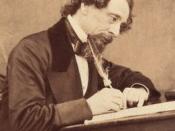In 1812, Charles Dickens was born the son of a destitute clerk. He had a limited education, and spent the majority of his childhood working in a dismal factory trying to earn money for his family. His early experiences gave him a compelling determination to make a success of his life, and he turned his hand to writing.
Dickens wrote "Great Expectations" in 1860 to promote his failing magazine. The novel allowed him to include his own childhood memories, as well as show the effects of society on a developing mind.
Dickens had a profound ability to use adjectives effectively. This is particularly recognisable with his use of imagery in chapter 8.
Satis House and Miss Havisham are vital aspects of the novel. Dickens has a tenacious understanding of how they are to be perceived, and conveys this to his audience in a comprehensive manner.
When Pip first comes across the manner house (chapter 8), it is described with a negative emphasis.
'...was of old brick, and dismal, ...' This proves very effective as it gives us an immediate impression of what the whole house is going to be like. Dickens also gives the house a sense of secrecy and isolation. 'Some of the windows had been walled up; of that remained, all the lower were rustily barred.' This also proves effective because in the first few sentences of description, Dickens has given Satis house an air of mystery, where everything involved may not be what one would expect. The fact that everything is under lock and key adds further mystery. The audience would want to continue reading from this point to discover more about the house and what it entails.
Dickens is constantly trying to give the impression that this dilapidated house was once magnificent, and he does this...


